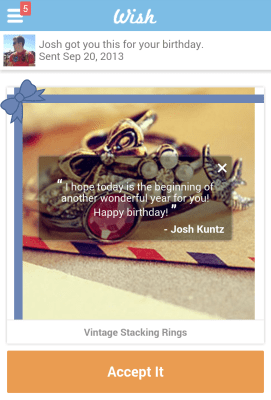Well, folks, it’s September. The holiday gift giving season is ON!
Wish, the mobile shopping app that lets users create lists of items they would like to purchase later, has launched Gifting, a feature that enables others to purchase and ship products to their friends. It draws from users’ existing wishlists and uses them to predict other items they would like. It’s a frazzled gift giver’s dream.
Gifting has been part of the plan since the inception of the app, Wish CEO Peter Szulczewski said, which makes every bit of sense, since it’s the natural other half to wishlist creation. At this point, Wish is seeing half a million people on the app daily, at an average session length of 29 minutes.
According to Szulczewski, sending presents was already a use case among Wish users prior to the feature’s launch this week. In looking at transactions, the team realized that people were requesting different shipping addresses for their purchases in order to send items to their friends.
In addition to allowing users to create and share targeted wishlists (the easiest way to get it right), Gifting also predicts items that friends most want and uses social integration to notify users on their friends’ birthdays.
“We use collaborative filtering in the same way that Amazon.com uses it,” Szulczewski said. “People that buy this will also buy these items.”
As Szulczewski explained, the Wish demographic skews toward the young and female. Gifting is a way to access an older demographic, like fathers who don’t really know what to buy their daughters, nieces, or granddaughters. While there are a slew of gifting apps out there — like Giftly for gift cards, the locally-focused Yiftee, Karma, and Wrapp — the fact that Wish draws on pre-existing knowledge of the recipient’s likes ups the giver’s odds of nailing it.
Wish has been bulking out its features this summer, having launched Wish Closet in late July to provide users a platform to resell their clothing. The plan is to grow internationally. Currently 55% of usage comes from North America, although there are growing communities in Europe and Latin America, which Szulczewski said present huge opportunities to grow the brand.
